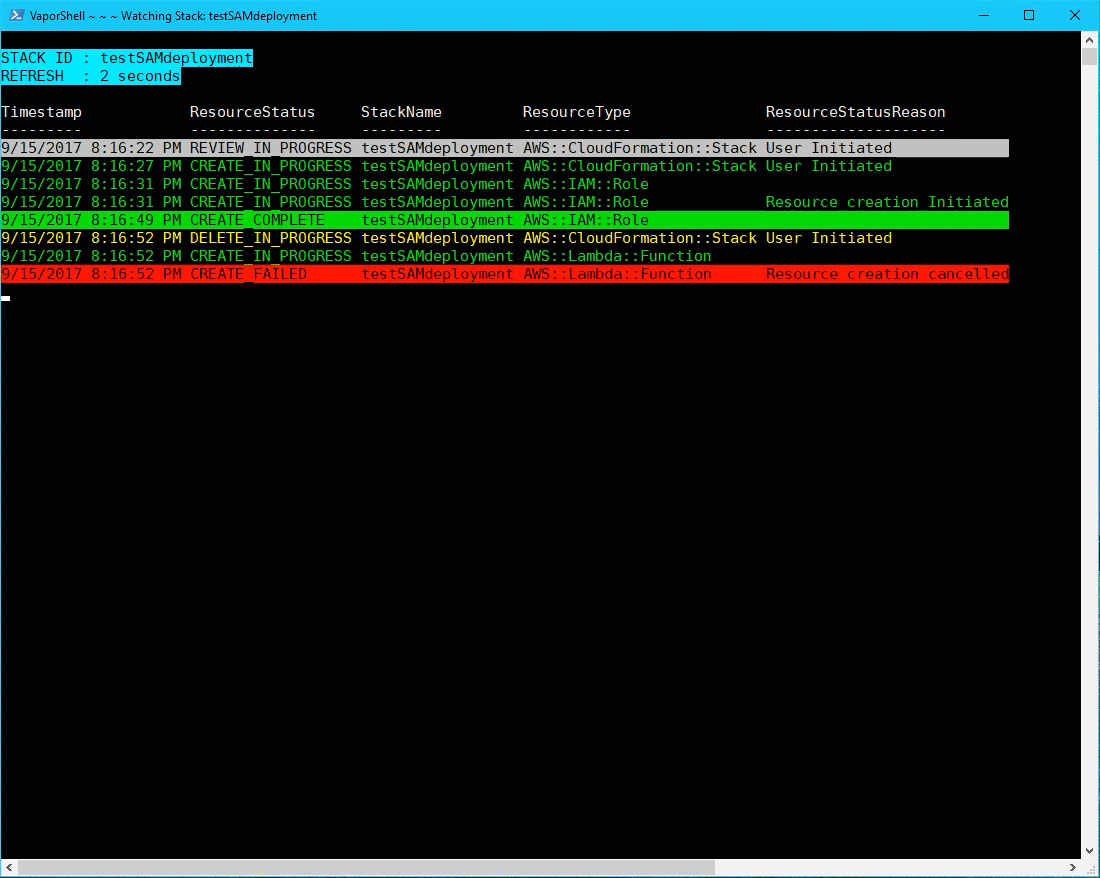- built from AWS's CloudFormation spec sheet: 100% coverage of all available resource and property types
- runs on any OS: developed and tested in Windows, Ubuntu, and macOS on PowerShell v3-6
- validates everything: built to make resulting templates reliable by leveraging parameter validation built into PowerShell
- goes turbo: package and deploy your templates fast with one command:
vsl vaporize
- PowerShell 3+
- On Linux or macOS? Grab PowerShell 6 here!
- .NET 4.5.0+ OR .netstandard 1.3+
- if you have PowerShell 4 or greater, you're covered!
Recommended: AWS Labs cfn-flip
If you are working with YAML templates, you need to install
cfn-flip. VaporShell usescfn-flipunder the hood to work with YAML templates, as PowerShell does not natively support YAML at this time. If you are only working in JSON, thencfn-flipisn't necessary.
[Preferred] On PowerShell 5+ or have PowerShellGet installed? Install directly from the PowerShell Gallery:
Install-Module VaporShell -Scope CurrentUser[Alternative] Not on PowerShell 5+, can't install PowerShellGet, or policies blocking installation from remote sources? You're covered as well:
- Head to the Releases section in the repo
- Download the VaporShell.zip file attached to the latest release.
- If on Windows: Right-click the downloaded zip, select Properties, then unblock the file.
This is to prevent having to unblock each file individually after unzipping.
- Unzip the archive.
- (Optional) Place the module folder somewhere in your
PSModulePath.You can view the paths listed by running the environment variable
$env:PSModulePath - Import the module, using the full path to the PSD1 file in place of
VaporShellif the unzipped module folder is not in yourPSModulePath:# In $env:PSModulePath Import-Module VaporShell # Otherwise, provide the path to the manifest file: Import-Module -Path C:\MyPSModules\VaporShell\2.6.2\VaporShell.psd1
If you are planning on packaging or deploying to CloudFormation, you will need to setup credentials in your local Shared Credentials file. If you are using the AWS command-line interface (CLI) and already have setup credentials, then you should be ready to go.
You can update or add a credential profile with Set-VSCredential:
Set-VSCredential -AccessKey $accessKey -SecretKey $secretKey -Region USWest1 -ProfileName DevAccountWhen building templates with VaporShell, there are typically a few items that you'll want to include in your build script:
- Create a template object by calling one of these into a variable
$template = Initialize-VaporShell- Use when starting from scratch
$template = Import-VaporShell -Path .\template.json- Use when importing from an existing template to build off of
- Build out your template by using the object's ScriptMethods:
$template.AddResource()$template.AddParameter()$template.AddOutput()- etc....
- Export your template to local file or
stdout(useful for piping directly intoNew-VSStackor other functions that support TemplateBody as pipeline input)Export-VaporShell -VaporshellTemplate $template -Path .\template.json- This will output the template as
template.jsonin your working directory
- This will output the template as
Export-VaporShell -VaporshellTemplate $template- This will output the template to
stdoutas a single string
- This will output the template to
$template.ToJSON()- This script method on the template object performs the same function as
Export-VaporShell -VaporshellTemplate $templateand outputs the string template as JSON tostdout
- This script method on the template object performs the same function as
$template.ToYAML()- This does the same thing as the
ToJSON()script method, but outputs to YAML (cfn-fliprequired)
- This does the same thing as the
#1 Initialize a VaporShell object
$vsl = Initialize-VaporShell -Description "A function triggered on a timer."
#2 Add a Serverless function with local code as the CodeUri and a schedule of 5 minutes (split into multiple lines for readability)
$samFunction = New-SAMFunction `
-LogicalId "ScheduledFunction" `
-Handler "index.handler" `
-Runtime "nodejs6.10" `
-CodeUri ".\code" `
-Events (Add-SAMScheduleEventSource -LogicalId Timer -Schedule "rate(5 minutes)")
$vsl.AddResource($samFunction)
$TemplateFile = ".\sched-func.yaml"
#3 Save the template as YAML using the VaporShell object's ToYAML() method (uses cfn-flip to convert to/from YAML)
$vsl.ToYAML($TemplateFile)
<#4 Package and deploy (vsl vaporize) the template file (--tf $TemplateFile) as a change set with parameters:
- stack name (--sn) 'sched-func'
- S3 bucket also named 'sched-func' (defaults to the stack name if --s3 is not passed)
- capabilities: CAPABILITY_IAM (--caps iam)
- Verbose (--v) enabled
- Force (--f) enabled (make sure that the bucket is created and objects are uploaded)
- Watch (--w) the stack events in colorized output after executing the change
#>
vsl vaporize --tf $TemplateFile --sn sched-func --caps iam --v --f --w
Check out the Examples page for more.
This is a deployment being watched via Watch-Stack $stackName to show stack creation and deletion mid-deploy:






